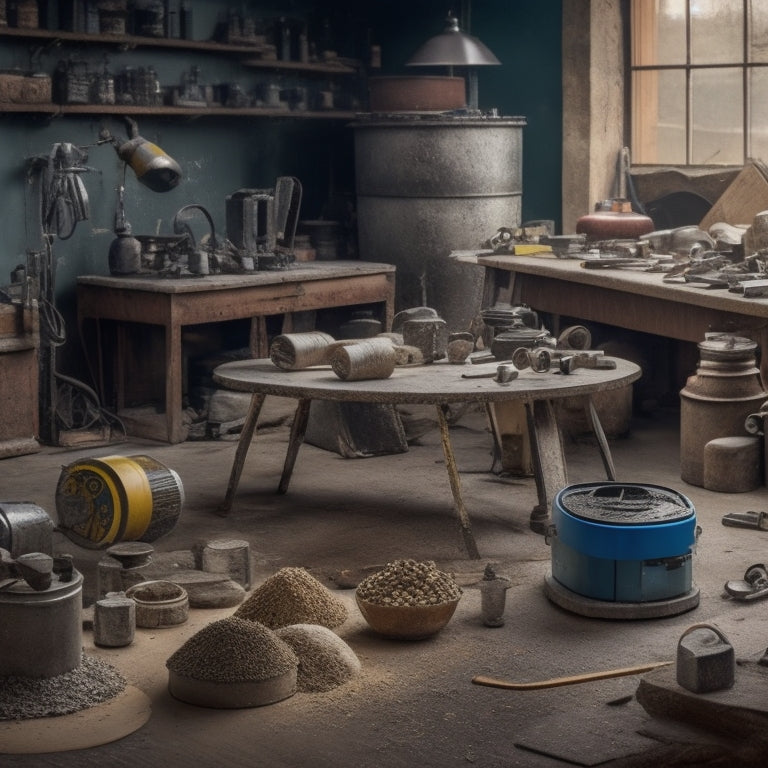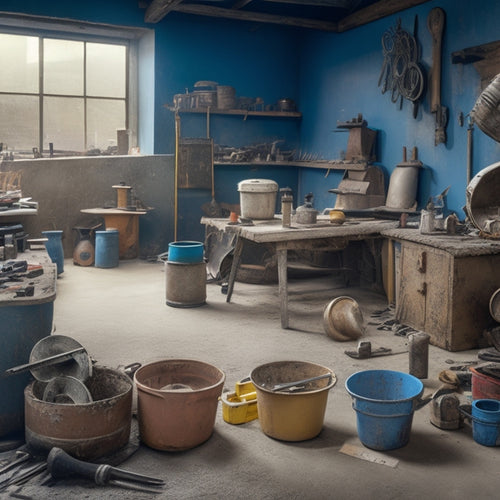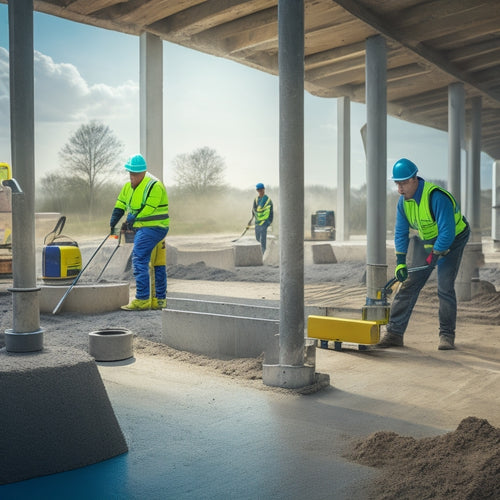
Top DIY Concrete Grinding and Polishing Tools
Share
When selecting DIY concrete grinding and polishing tools, you'll want to take into account a range of factors to guarantee a high-quality finish and safe working environment. Start by choosing the right concrete grinding machine, such as a walk-behind, handheld, or planetary grinder, and think about variable speed options with soft-start features. Polishing tools, like grit sequencing and dustless polishing systems, are also essential for achieving a smooth finish. Additionally, don't forget edger and sander combos, floor preparation tools, and essential safety equipment. As you explore these tool categories, you'll discover the perfect combination to tackle your project with precision and confidence, and uncover the secrets to a flawless concrete finish.
Key Takeaways
• Choose the right grinder type (walk-behind, handheld, or planetary) based on the task requirements and desired surface finish.
• Select a variable speed grinder with a suitable speed range (300-1,200 RPM) and soft-start feature for enhanced control and safety.
• Follow a precise grit sequence (coarse, medium, fine) to avoid rework and ensure a high-quality finish in polishing tasks.
• Invest in a dustless polishing system with a powerful vacuum or dust extractor to minimize airborne silica and ensure a clean working environment.
• Always wear protective gear, including gloves, safety glasses, and dust masks, during grinding and polishing operations to prioritize safety.
Essential Concrete Grinding Machines
You'll need a range of concrete grinding machines to tackle various tasks, from coarse grinding to fine polishing. These essential tools will form the backbone of your DIY concrete grinding and polishing arsenal.
For effective grinding, consider a walk-behind grinder, ideal for large areas, or a handheld grinder for smaller, more intricate tasks. A planetary grinder is also a must-have, offering increased productivity and versatility.
To guarantee prime performance and safety, prioritize grinder maintenance tips. Regularly inspect and replace worn-out grinding pads, and keep your machines clean and well-lubricated.
Additionally, always wear safety equipment essentials, such as gloves, safety glasses, and a dust mask, to protect yourself from flying debris and airborne particles.
Polishing Tools for Smooth Finish
Now that you've ground your concrete to the desired level, it's time to focus on achieving a smooth finish using the right polishing tools.
You'll need to choose the appropriate polisher type for your project, decide on a grit sequence that won't scratch your surface, and master edge work techniques to guarantee a seamless finish.
Polisher Types Compared
When selecting a polisher for a smooth finish, it's essential to evaluate the distinct characteristics of each type, as they significantly impact the quality and efficiency of the concrete grinding and polishing process.
You'll want to take into account the polisher features that matter most, such as motor power, pad size, and weight distribution. For instance, planetary polishers are ideal for large areas, offering high-speed grinding and polishing with multiple heads. On the other hand, rotary polishers are better suited for smaller areas, providing more control and precision.
Some reputable polisher brands, like Husqvarna and Metabo, offer a range of models with varying features. Husqvarna's PG 820, for example, boasts a powerful 18-amp motor and 20-inch grinding path, making it perfect for large commercial projects. Metabo's RS14-125, on the other hand, is a compact and lightweight rotary polisher ideal for small to medium-sized jobs.
Grit Sequence Matters
To achieve a smooth, high-gloss finish, it's essential that you follow a precise grit sequence with your polishing tools. Skipping or misordering grits can lead to costly rework, surface defects, and compromised durability.
A well-planned grit progression is vital to removing scratches and imperfections, allowing you to achieve a flawless finish.
Here's what you can expect at each stage of the grit application process:
-
Coarse grits (16-30): Aggressive removal of surface imperfections, old coatings, and unevenness.
-
Medium grits (40-80): Refining the surface, removing scratches, and creating a uniform texture.
-
Fine grits (100-3000): Polishing and honing the surface to a high-gloss finish, removing minor imperfections and scratches.
Edge Work Essentials
You'll need to equip yourself with specialized edge work tools, such as hand-held grinders and diamond-impregnated pads, to achieve a smooth finish and seamlessly blend the polished edges with the surrounding concrete surface. These tools will enable you to master edge finishing techniques and tackle challenging corner grinding tasks with confidence.
When working on edges, prioritize safety by wearing protective gear, including gloves, safety glasses, and a dust mask.
To achieve a flawless edge finish, start by using a hand-held grinder with a diamond-impregnated pad to remove any imperfections or old coatings. Next, progress to higher grit pads (16, 30, and 60) to refine the edge, feathering the polish out towards the surrounding concrete.
For corner grinding tips, use a specialized corner grinder or a hand-held grinder with a corner attachment to access tight spaces. Always maintain a consistent angle and apply moderate pressure to avoid creating swirl marks or scratches.
Edger and Sander Combo Options
When you're working on a concrete project, achieving a professional-looking finish requires attention to detail, especially around edges.
That's where edger and sander combo tools come in, offering you precise edge control and the ability to tackle both edging and sanding tasks with ease.
You'll want to evaluate options that feature dual-head sander designs, which allow you to switch between tasks quickly and efficiently.
Precise Edge Control
Achieving precise edge control requires a combination of the right edger and sander tools, as these specialized machines allow you to refine and polish concrete edges with precision and accuracy.
When working with concrete, you need to maintain control over the edges to prevent damage, guarantee safety, and achieve professional-looking results.
To achieve precise edge control, you'll want to reflect on the following key features in your edger and sander combo:
-
Edge beveling techniques: Look for tools that allow for precision angle adjustments, enabling you to create smooth, rounded edges or sharp, defined angles.
-
Variable speed control: This feature enables you to adjust the speed of your edger and sander to suit different concrete types and edge profiles.
-
Dust collection systems: A built-in dust collection system helps minimize dust and debris, improving visibility and reducing the risk of respiratory issues.
Dual-Head Sanders
By opting for a dual-head sander, which combines an edger and sander in one unit, you can efficiently tackle both tasks simultaneously, streamlining your concrete grinding and polishing process. This setup allows you to alternate between edging and sanding without having to change tools, saving you time and effort.
Dual-head sanders offer several advantages, including increased productivity, reduced fatigue, and improved surface quality.
When using a dual-head sander, it's crucial to employ proper sanding techniques to achieve the best results. Start by adjusting the sanding heads to the correct angle and pressure, ensuring even contact with the concrete surface. Then, work in sections, overlapping your passes to maintain uniformity. Be cautious when shifting between edging and sanding modes, as this can cause scratches or swirl marks.
Remember to always wear protective gear, including gloves, safety glasses, and a dust mask, to minimize exposure to concrete dust and debris.
Concrete Floor Preparation Tools
You'll need a range of concrete floor preparation tools to remove old coatings, adhesive, and contaminants, and to repair cracks and joints before grinding and polishing. This critical step assures a strong bond between the concrete surface and the polishing compounds.
To begin, perform a thorough concrete surface assessment to identify areas that require repair. Then, employ floor repair techniques such as patching and filling to create a smooth, even surface.
Some essential tools for concrete floor preparation include:
-
Scrapers and chisels to remove old coatings and adhesive
-
Crack chasers and joint fillers to repair cracks and joints
-
Floor scrapers and edgers to remove contaminants and old flooring material
Remember to always wear personal protective equipment (PPE) when working with concrete floor preparation tools, including safety glasses, gloves, and a dust mask.
Variable Speed Grinder Reviews
With a well-prepared concrete floor, it's time to move on to the grinding phase, where a variable speed grinder becomes an important tool in your arsenal. You'll want to choose a grinder that offers variable speed benefits, allowing you to adjust the speed to suit the specific task at hand. This flexibility is vital, as it enables you to enhance your grinding process and achieve the best results.
When selecting a variable speed grinder, look for one that offers a range of ideal speed settings. Typically, you'll want a grinder that can operate between 300 and 1,200 RPM. This range will allow you to tackle everything from aggressive grinding to fine polishing. Additionally, consider a grinder with a soft-start feature, which reduces the risk of kickback and improves overall safety.
Some top-rated variable speed grinders on the market include the DeWalt DCG412B and the Metabo PWE11-100. Both of these grinders offer exceptional performance, durability, and safety features. By investing in a high-quality variable speed grinder, you'll be well-equipped to tackle even the most demanding concrete grinding projects.
Dustless Polishing System Options
As you shift from grinding to polishing, incorporating a dustless polishing system into your workflow becomes vital to minimize airborne silica and maximize visibility. This is significant for your health and safety, as well as the quality of your work. A dustless polishing system guarantees that you can work efficiently while maintaining a clean and safe environment.
When selecting a dustless polishing system, consider the following key features:
-
Dust collection: Look for a system that uses a powerful vacuum or dust extractor to capture 99% of dust and debris, preventing them from becoming airborne.
-
Water usage: Opt for a system that utilizes a minimal amount of water, reducing mess and making cleanup easier.
-
Sealed polishing heads: Verify that the polishing heads are fully sealed to prevent dust and debris from escaping during the polishing process.
Frequently Asked Questions
Can I Use a DIY Grinder on an Industrial Concrete Floor?
When considering using a DIY grinder on an industrial concrete floor, you need to think twice.
Industrial floors are built to withstand heavy traffic and machinery, making them much harder than residential floors. A DIY grinder, designed for smaller projects, may not be powerful enough to effectively grind the floor.
You risk damaging the grinder, the floor, or even injuring yourself. It's essential to assess the floor's condition and consider renting or hiring a professional with industrial-grade equipment to guarantee a safe and successful outcome.
Do I Need to Rent or Buy Concrete Grinding Equipment?
You're wondering whether to rent or buy concrete grinding equipment.
It's essential to weigh the cost comparison. Renting might be more cost-effective for a one-time project, but if you plan to use the equipment frequently, buying could be more economical in the long run.
Additionally, consider equipment maintenance - renting often means less maintenance responsibility, while buying requires regular upkeep.
Are Concrete Polishing Tools Suitable for Epoxy-Coated Floors?
As you venture into the world of epoxy-coated floors, you're maneuvering a delicate dance between beauty and durability.
When it comes to polishing these floors, you'll need to choose tools that are compatible with epoxy coatings. Not all polishing techniques are created equal, and some can actually damage the epoxy.
Look for tools specifically designed for epoxy compatibility, and always follow the manufacturer's instructions to guarantee a safe and successful polishing process.
How Do I Choose the Right Grit Sequence for My Project?
When choosing the right grit sequence for your project, you'll need to evaluate the specific requirements of your floor.
Start by examining the floor's condition, taking note of any scratches, imperfections, or existing coatings.
Next, determine the desired finish and take into account factors like floor traffic and maintenance needs.
Follow grit selection tips, such as starting with a coarse grit and progressing to finer ones, to guarantee a safe and effective process.
Can I Grind Concrete in a Small, Enclosed Space Safely?
When you're planning to grind concrete in a small, enclosed space, it's essential to debunk the myth that 'a little dust won't hurt.'
In reality, concrete dust can be hazardous to your health. To guarantee ventilation safety, you'll need a dust containment system that captures 99% of airborne particles.
This means investing in a high-quality vacuum or dust extractor with a HEPA filter.
Don't compromise on safety - prioritize proper ventilation and dust containment to avoid respiratory issues and other health risks.
Conclusion
As you stand back to admire your transformed concrete floor, the reflection of your hard work stares back at you - a polished mirror of dedication and perseverance.
The once-dull surface now radiates a brilliance that echoes the sweat and toil invested in its rebirth.
With the right DIY concrete grinding and polishing tools, you've revealed a masterpiece, and the results are nothing short of breathtaking.
Related Posts
-

3 Best Hand Tools for DIY Concrete Construction
When tackling a DIY concrete construction project, you'll need three essential hand tools to achieve a professional-l...
-

Best Tools for Concrete Restoration and Repair
When tackling concrete restoration and repair projects, you need a range of reliable tools to achieve professional-gr...
-

What Tools Ensure Precise Concrete Leveling Results
You need a range of specialized tools to achieve precise concrete leveling results. Laser leveling instruments provid...


